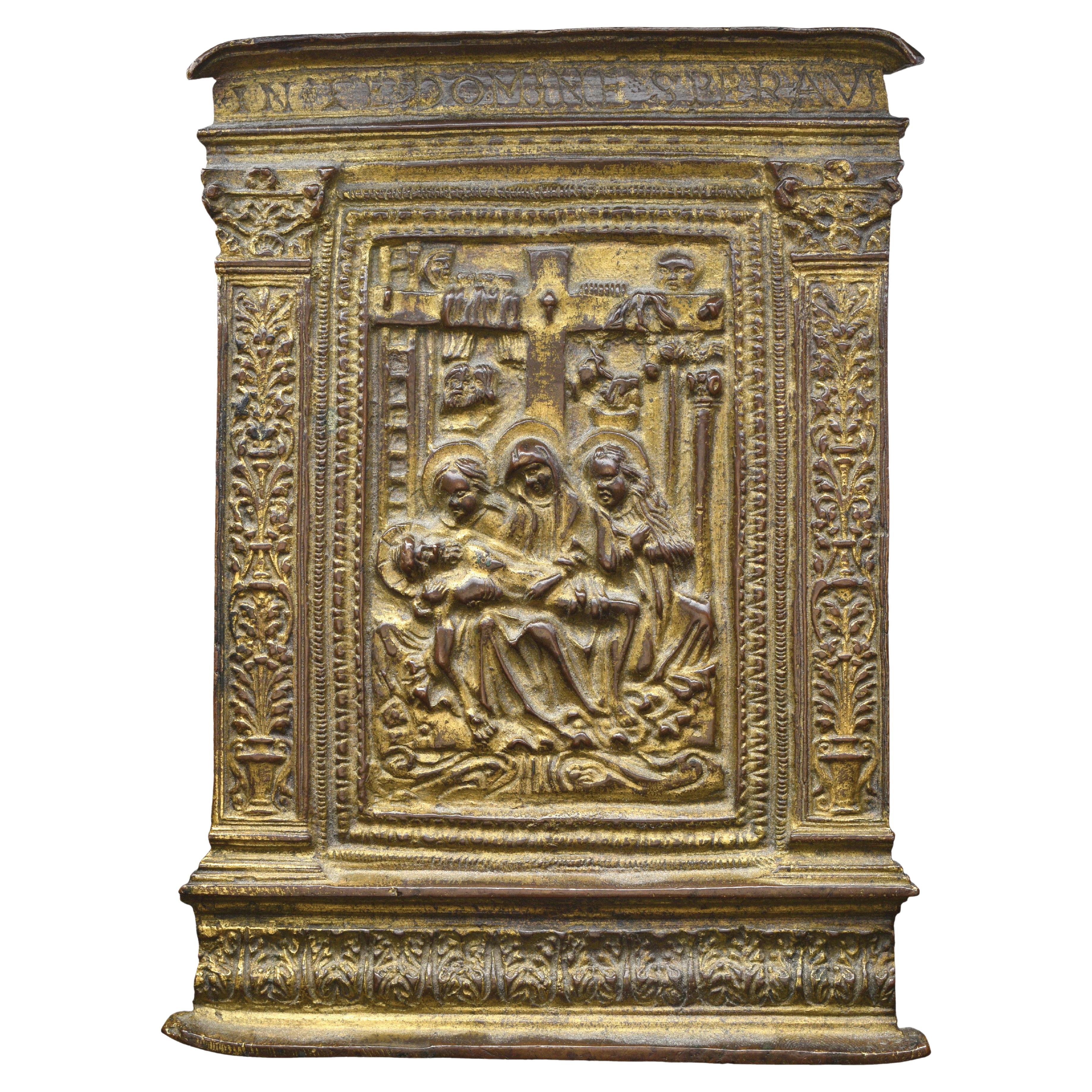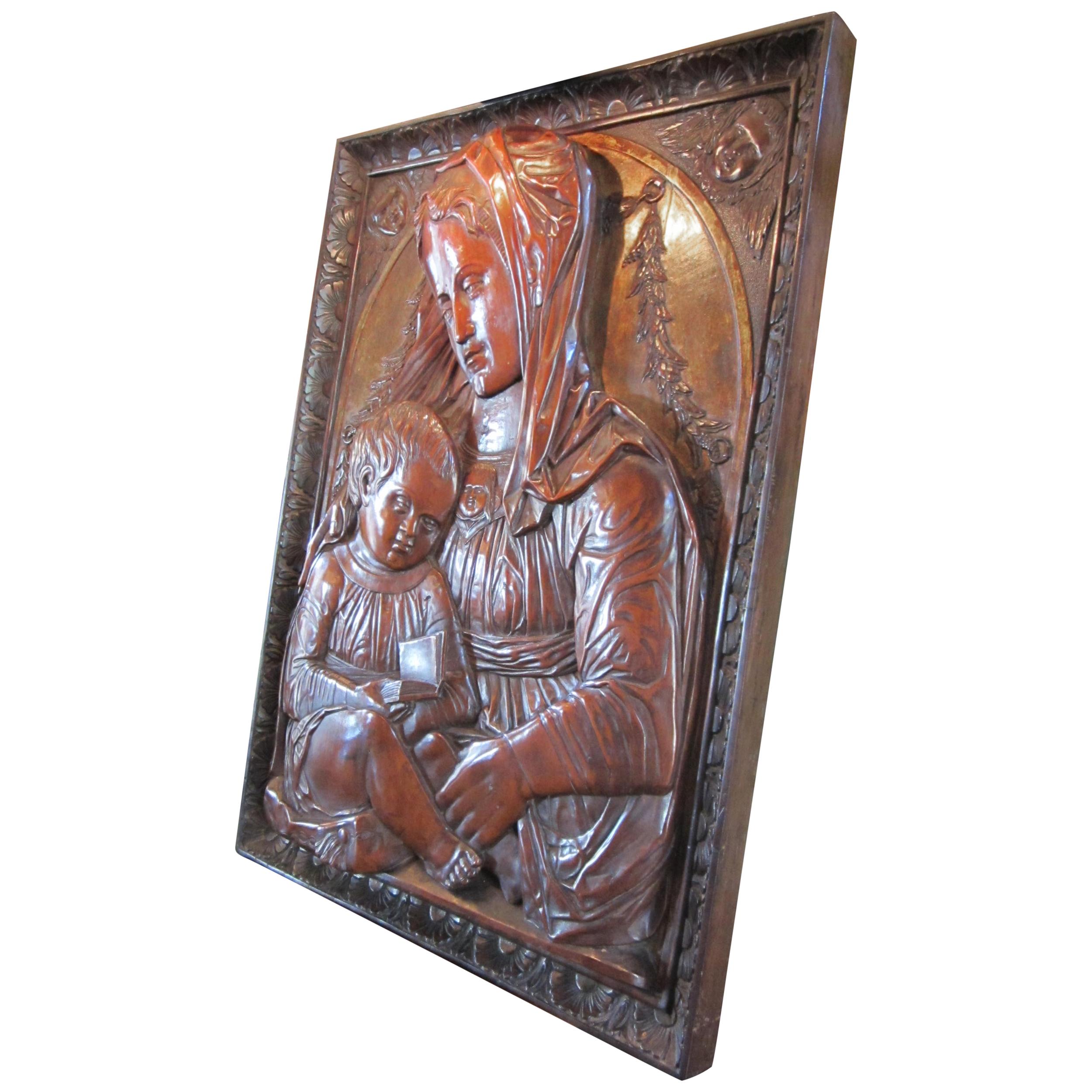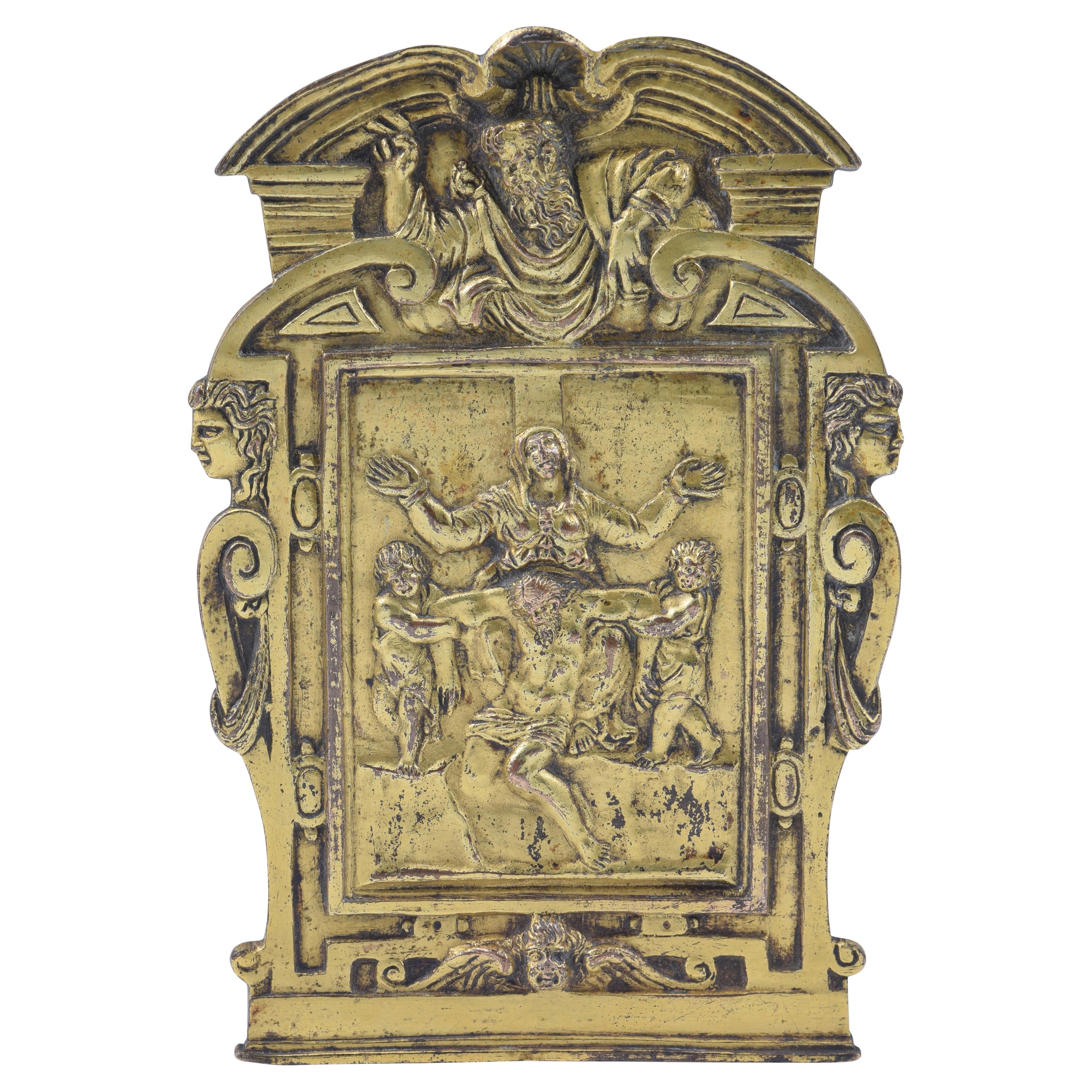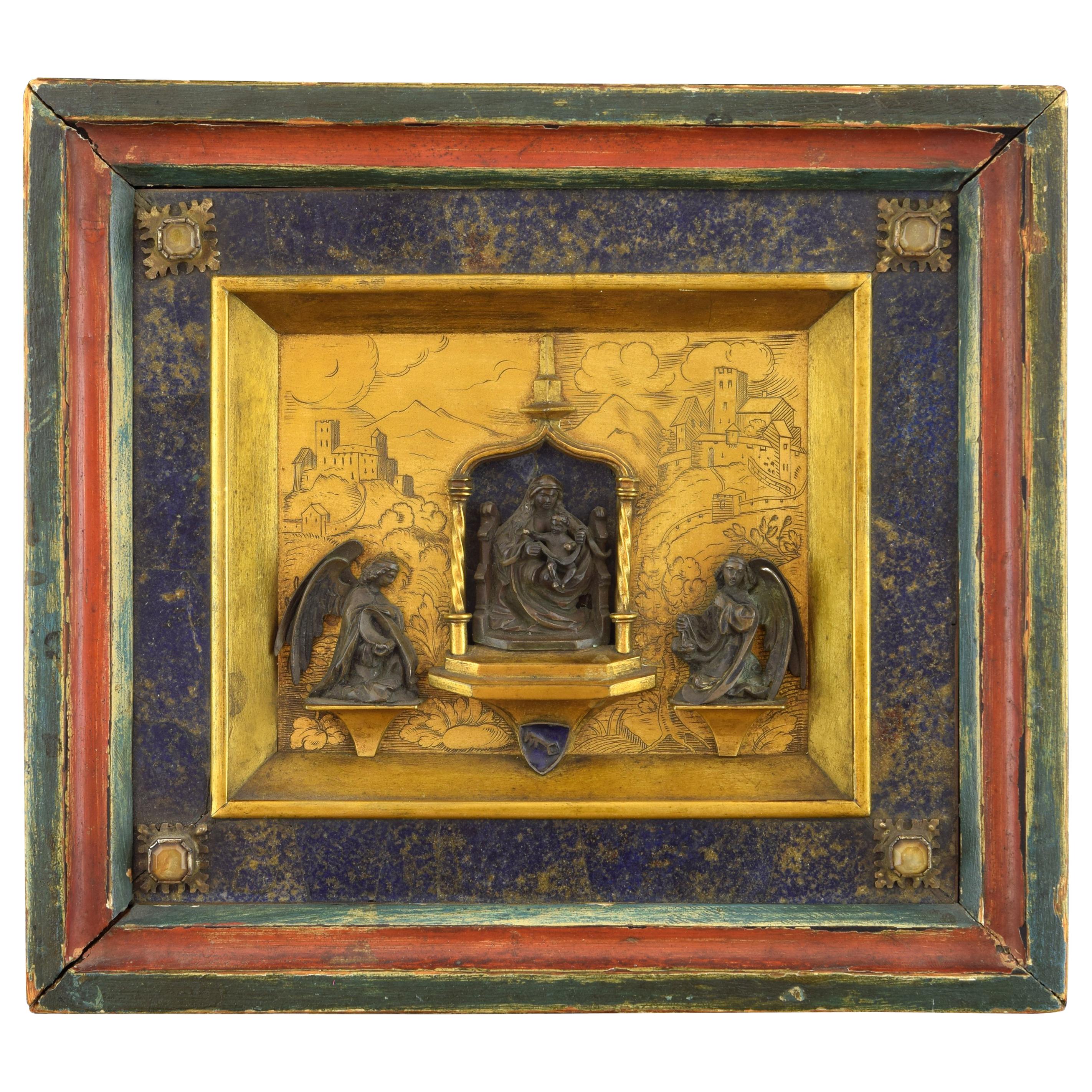Items Similar to 15th century Gilt Bronze Pax of the Virgin and Child, after Donatello
Want more images or videos?
Request additional images or videos from the seller
1 of 5
15th century Gilt Bronze Pax of the Virgin and Child, after Donatello
About the Item
Anonymous, school of Donatello
Second half of the 15th century; Northern Italy
Approximate size: 13 x 7.6 cm
The present relief of the Virgin and Child is largely considered derived from either a lost model by Donatello or perhaps inspired in close proximity with his creation of the Piccolomini Madonna in Siena. The relief plaquette itself was widely dispersed and more than three dozen examples survive in various private and public collections. The present example, formed as an applique, is a later debased variant of the original composition but its motif is reproduced variably on other paxes and was later used also as a model for bell founders where the motif is featured on productions from the workshop of Giulio and Ludovico Bonaventurini and the foundry of Giuseppe de’ Levis during the late 16th and early 17th centuries. It is copied on a relief dated 1511 on the façade of the Ospedale dei Poveri Sarti in Venice and the motif is also copied, at an early date, ca. 1530-40, on a footed maiolica dish from the Gubbio.
The art historian John Pope-Hennessy described this relief to be ‘of great distinction’ while the scholar Jeremy Warren commented on it as ‘one of the most beautiful of the small reliefs of the Virgin and Child associated with Donatello.’
The separately cast, although contemporaneously produced frame for the pax is certainly an old model of the late 15th century. It’s base features the inscription: SANCTVS SALVATOR MONDI (Savior of the world). The integrally cast lunette features God the Father flanked by a pair of putti. The columns, lunette and entablature feature an alternating pattern of shells and rosettes.
An example of this frame, featuring a relief of the Resurrection of Christ by Moderno, in the collection of Mario Scaglia, features an inscription on its reverse: ROME 1504, indicating a terminus ante quem for the frame’s existence. Francesco Rossi suggests the frame has its origin in the Veneto which seems a probable location for the facture of the present pax.
- Dimensions:Height: 5.11 in (12.98 cm)Width: 3 in (7.62 cm)Depth: 1 in (2.54 cm)
- Style:Renaissance (Of the Period)
- Materials and Techniques:
- Place of Origin:
- Period:
- Date of Manufacture:Unknown
- Condition:Wear consistent with age and use.
- Seller Location:Leesburg, VA
- Reference Number:1stDibs: LU8166235783102
About the Seller
5.0
Vetted Seller
These experienced sellers undergo a comprehensive evaluation by our team of in-house experts.
Established in 2013
1stDibs seller since 2023
19 sales on 1stDibs
Typical response time: 6 hours
- ShippingRetrieving quote...Ships From: Leesburg, VA
- Return PolicyThis item cannot be returned.
More From This SellerView All
- 15th century North Italian Gilt Bronze Pax of the LamentationLocated in Leesburg, VAAnonymous Second half of the 15th century; Northern Italy, possibly Milan Gilt bronze Approximate size: 17.2 x 13 cm The present pax probably derives from a finer original realized in more precious materials. For example, the vigor of its central motif is carved in such a way as to suggest the original artwork was conceived in carved stone or perhaps mother-of-pearl. The intricacy of its frame suggests a separate master adept in silverwork. Overall, this bronze pax...Category
Antique 15th Century and Earlier Italian Renaissance Religious Items
MaterialsBronze
- Ebony Wood and Gilt Bronze Reliquary Altar Cross After GiambolognaLocated in Leesburg, VAAnonymous (corpus after a model by Giambologna) circa 1700; Netherlandish or Northern Rhinish Ebonized wood, gilt bronze appliques and statuettes, textiles and relics Approximat...Category
Antique 1690s Dutch Baroque Religious Items
MaterialsBronze
- A 17th century Roman Altar Cross after Guglielmo della PortaLocated in Leesburg, VAA 17th century Roman altar cross after Guglielmo della Porta Approximate size: 67 x 27 cm The present altar cross, likely of Italian Roman origin, reprod...Category
Antique 17th Century Italian Renaissance Religious Items
MaterialsAgate, Lapis Lazuli, Bronze
- 19th Century Articulated Wooden Figure of the Virgin MaryLocated in Leesburg, VA19th century articulated wooden figure of the Virgin Mary Anonymous Spain; 19th century Polychrome wood, inset glass eyes Approximate size: 37 x 11 x 7 cm An antique ‘Virgin...Category
Antique 19th Century Primitive Figurative Sculptures
MaterialsGlass, Wood, Paint
- A large 16th century Italian etching of the Vision of St. Peter after TintorettoLocated in Leesburg, VAAN UNUSUALLY LARGE 16TH CENTURY ITALIAN ETCHING OF THE VISION OF ST. PETER AFTER JACOPO TINTORETTO Anonymous, after Jacopo Tintoretto Italy; 16th century Printed on laid paper with ...Category
Antique 16th Century Italian Baroque Prints
MaterialsPaper
- Rare and important painted bronze Crucifix after a model by MichelangeloBy Michelangelo BuonarrotiLocated in Leesburg, VAA rare and very fine bronze corpus of Christ after a model by Michelangelo, cast ca. 1597-1600 by Juan Bautista Franconio and painted in 1600 by Francisco Pacheco in Seville, Spain. The present corpus reproduces a model attributed to Michelangelo. The best known example, lesser in quality, is one on display at the Metropolitan Museum of Art (MET). The association of this corpus with Michelangelo was first brought to light by Manuel Gomez-Moreno (1930-33) who studied the wider circulated casts identified throughout Spain. The attribution to Michelangelo was subsequently followed by John Goldsmith-Phillips (1937) of the MET and again by Michelangelo expert, Charles de Tolnay (1960). While Michelangelo is best known for his monumental works, there are four documented crucifixes he made. The best known example is the large-scale wooden crucifix for the Church of Santa Maria del Santo Spirito in Florence, made in 1492 as a gift for the Prior, Giovanni di Lap Bicchiellini, for allowing him to study the anatomy of corpses at the hospital there. In 1562, Michelangelo wrote two letters to his nephew, Lionardo, indicating his intention to carve a wooden crucifix for him. In 1563 a letter between Lionardo and the Italian sculptor Tiberio Calcagni, mentions this same crucifix (a sketch of a corpus on the verso of a sheet depicting Michelangelo’s designs for St. Peter’s Basillica [Palais des Beaux-Arts in Lille] may reproduce this). That Michelangelo was working on small corpora in the last years of his life is further evidenced by the small (26.5 cm) unfinished wooden crucifix located at the Casa Buonarroti, considered his last known sculptural undertaking. Michelangelo’s contemporary biographer, Giorgio Vasari additionally cites that Michelangelo, in his later years, made a small crucifix for his friend, Menighella, as a gift. Surviving sketches also indicate Michelangelo’s study of this subject throughout his career, most notably during the end of his life but also during the 1530s-40s as he deepened his spiritual roots. The occasional cameo of crucified Christ’s throughout his sketched oeuvre have made it challenging for scholars to link such sketches to any documented commissions of importance. All the while, in consideration that such objects were made as gifts, it is unlikely they should be linked with commissions. Nonetheless, a number of theories concerning Michelangelo’s sketches of Christ crucified have been proposed and some may regard the origin of the present sculpture. It has been suggested that the corpus could have its impetus with Michelangelo’s work on the Medici Chapel, whose exclusive design was given to the master. It is sensible smaller details, like an altar cross, could have fallen under his responsibility (see for example British Museum, Inv. 1859,0625.552). Others have noted the possibility of an unrealized large marble Crucifixion group which never came to fruition but whose marble blocks had been measured according to a sheet at the Casa Buonarroti. A unique suggestion is that Michelangelo could have made the crucifix for Vittoria Colonna, of whom he was exceedingly fond and with whom he exchanged gifts along with mutual spiritual proclivities. In particular, Vittoria had an interest in the life of St. Bridget, whose vision of Christ closely resembles our sculpture, most notably with Christ’s proper-left leg and foot crossed over his right, an iconography that is incredibly scarce for crucifixes. The suggestion could add sense to Benedetto Varchi’s comment that Michelangelo made a sculpted “nude Christ…he gave to the most divine Marchesa of Pescara (Vittoria Colonna).” Of that same period, two sketches can be visually linked to our sculpture. Tolnay relates it to a sketch of a Crucified Christ at the Teylers Museum (Inv. A034) of which Paul Joannides comments on its quality as suggestive of preparations for a sculptural work. Joannides also calls attention to a related drawing attributed to Raffaello da Montelupo copying what is believed to be a lost sketch by Michelangelo. Its relationship with our sculpture is apparent. Montelupo, a pupil of Michelangelo’s, returned to Rome to serve him in 1541, assisting with the continued work on the tomb of Pope Julius II, suggesting again an origin for the corpus ca. 1540. The earliest firm date that can be given to the present corpus is 1574 where it appears as a rather crudely conceived Crucifixion panel, flanked by two mourners in low-relief and integrally cast for use as the bronze tabernacle door to a ciborium now located at the Church of San Lorenzo in Padula. Etched in wax residue on the back of the door is the date, 27 January 1574, indicating the corpus would have at least been available as a model by late 1573. The Padula tabernacle was completed by Michelangelo’s assistant, Jacopo del Duca and likely has its origins with Michelangelo’s uncompleted tabernacle for the Basilica of St. Mary of the Angels in Rome. The impetus for the Padula tabernacle’s Crucifixion panel begins with a series of late Crucifixion sketches by Michelangelo, depicting a scene of Christ crucified and flanked by two mourners (see British Museum Inv. 1895.0915.510; Ashmolean Museum Inv. 1846.89, KP II 343 recto; Windsor Castle RCIN 912761 recto; and Louvre Inv. 700). A faintly traced block possibly intended for sculpting the sketch of the crucified Christ on its recto was discovered by Tolnay on a version of the composition at Windsor Castle. The Windsor sketch and those related to it appear to have served as preparatory designs for what was probably intended to become the Basilica of St. Mary’s tabernacle door. Vasari documents that the project was to be designed by Michelangelo and cast by his assistant, Jacopo del Duca. Michelangelo died before the commission was complete, though on 15 March 1565, Jacopo writes to Michelangelo’s nephew stating, “I have started making the bronze tabernacle, depending on the model of his that was in Rome, already almost half complete.” Various circumstances interrupted the completion of the tabernacle, though its concept is later revitalized by Jacopo during preparations to sell a tabernacle, after Michelangelo’s designs, to Spain for Madrid’s El Escorial almost a decade later. The El Escorial tabernacle likewise encountered problems and was aborted but Jacopo successfully sold it shortly thereafter to the Carthusians of Padula. An etched date, 30 May 1572, along the base of the Padula tabernacle indicates its framework was already cast by then. A 1573 summary of the tabernacle also describes the original format for the door and relief panels, intended to be square in dimension. However, a last minute decision to heighten them was abruptly made during Jacopo’s negotiations to sell the tabernacle to King Phillip II of Spain. Shortly thereafter the commission was aborted. Philippe Malgouyres notes that the Padula tabernacle’s final state is a mixed product of the original design intended for Spain’s El Escorial, recycling various parts that had already been cast and adding new quickly finished elements for its sale to Padula, explaining its unusually discordant quality, particularly as concerns the crudeness of the door and relief panels which were clearly made later (by January 1574). Apart from his own admission in letters to Spain, it is apparent, however, that Jacopo relied upon his deceased master’s designs while hastily realizing the Padula panels. If Michelangelo had already earlier conceived a crucifix model, and Jacopo had access to that model, its logical he could have hastily employed it for incorporation on the door panel to the tabernacle. It is worth noting some modifications he made to the model, extending Christ’s arms further up in order to fit them into the scale of the panel and further lowering his chin to his chest in order to instill physiognomic congruence. A crude panel of the Deposition also follows after Michelangelo’s late sketches and is likewise known by examples thought to be modifications by Jacopo based upon Michelangelo’s initial sculptural conception (see Malgouyres: La Deposition du Christ de Jacopo del Duca, chef-d’oeuvre posthume de Michel-Ange). Jacopo’s appropriation of an original model by Michelangelo for more than one relief on the Padula tabernacle adds further indication that the crucifix was not an object unique to Jacopo’s hand, as few scholars have posited, but rather belongs to Michelangelo’s original...Category
Antique 16th Century Renaissance Figurative Sculptures
MaterialsBronze
You May Also Like
- 15th Century Gothic VirginLocated in Madrid, ES15th century Gothic Virgin Gothic Virgin of the 15th century Virgin in carved and polychrome wood of the 15th century. In its original state, muse...Category
Antique 15th Century and Earlier Figurative Sculptures
MaterialsWood
- Carved Fruitwood Plaque of Virgin and Child Madonna, after Donatello SculptureLocated in West Hollywood, CACarved Fruitwood Plaque of Virgin and Child Madonna, after Donatello Sculpture . A Large Beautifully 18th/19th Century Carved Relief Fruitwood partially gilt of “ MADONNA AND CHILD”...Category
Antique 18th Century Italian Wall-mounted Sculptures
MaterialsWood, Giltwood
- 15th Century Spanish Gothic Virgin and Child Polychrome Wooden SculptureLocated in Marbella, ES15th century Spanish Gothic Virgin and child polychrome figurative wooden sculpture.Category
Antique 15th Century and Earlier Religious Items
MaterialsWood
- Gilt bronze pax board, Pietà. 16th-17th centuries, after Michelangelo BuonarrotiLocated in Madrid, ESPeacekeeper, Mercy. Golden bronze. Possibly Rome, last third of the 16th century-first quarter of the 17th century, following the model of Michelangelo Buonarroti. Gilded bronze pla...Category
Antique Early 17th Century European Renaissance Religious Items
MaterialsOther, Bronze
- "Madonna with Child and Angels". Italy, 15th-16th CenturiesLocated in Madrid, ESBronze in its color and gold, lapis lazuli, rock crystal, enamel. In the centre of the work is presented, enthroned, the figure of Mary, with a mantel (fireplace) on her shoulders and hair and holding on her knees the child, who appears addressing one of the angels. The virgin is also sheltered by an ogee arch supported on turned columns, and raised visually by steps. This composition achieves a very striking contrast: the dark bronze figure, in contrast to the lapis lazuli background and the part of the arch and the outside of it, in gilded bronze. Under the steps there is a heraldic enamel shield with a key on an azure background. The angels, kneeling, are flanking this figure, and, appearing in dark bronze, visually share the "category" of religious figures with Mary, while their (lower) position gives more status to both the Mother and Jesus. The rest of the composition is completed with a delicate landscape: constructions and walls on mountains, clouds in the sky, plants, stones, etc. To the outside, another lapis lazuli frame is placed decorated in the corners with appliques, giving way to carved and polychrome wood. The lapis lazuli is a semiprecious stone already known in the seventh millennium BC., found in deposits from the Caucasus to Mauritania. From the end of the middle ages, it increased its export to Europe, its use being more frequent since then both to use it as a pigment in paintings after grinding it (giving rise to the finest and most expensive of the blues, and of the colors in many occasions), as for backgrounds of paintings, incrustations in works of art, jewelry and, a little later, in the well-known "hard stone works". The figure of Mary still shows an influence of Gothic models, although more European than Italian, along with elements that could already show a closeness to the Renaissance: although the nakedness of Jesus is already shown in Gothic works (Madonna with Angels by Fra Angelico ), the creation of space by playing with the cloth in front of Christ can be appreciated in more advanced paintings (Virgin with Child by Domenico Ghirlandaio, National Gallery of London); the presence of a powerful throne can be seen frequently in Italian Madonnas of the Quattrocento (and before), but not quite as presented here. As for the landscape, it is necessary to compare it, for example, with that of the fresco of the Condotiero Guidoriccio de Fogliano (Simone Martini, finished in 1328). This is a work of great technical and aesthetic quality, not to mention the materials chosen for its creation, comparable only to outstanding examples from around the world, such as those preserved in the Palazzo Madama in Torino (Italy), where the coral It also has an important role. It is essential to mention, also, works such as the plate of hard stones (lapis lazuli between them) with a relief of Mary with the Child in...Category
Antique 16th Century Italian Renaissance Religious Items
MaterialsLapis Lazuli, Bronze, Enamel, Other
- Bronze Pax or Pax Board, 16th CenturyLocated in Madrid, ESPaper holder bronze, 16th century. Bronze paper holder with a flat curved handle on the back that features a relief decoration organized in the front through an architectural composition with a classical influence usual in the Renaissance. Under the columns on the sides there are two heraldic shields (without bonnet, laces with tassels on three levels) with a Latin cross in the middle zone; the center shows a birth of Christ under a winged dome with heads of winged angels in the corners; at the top and under a semi-circular arch, the bust of Saint Dominic...Category
Antique 16th Century Spanish Renaissance Religious Items
MaterialsBronze
Recently Viewed
View AllMore Ways To Browse
Sacred Heart Ex Voto
10 Commandments
Austrian Menorah
Gothic Incense
Antique Italian Silver Ex Voto
Menorah Solid Silver
Tabernacle Niche
Vintage Inri Cross
Antique Advent Wreath
Antique Oak Church Lectern
French Giltwood Religious Jesus
Holy Water Wood Fonts
Miniature Bibles
Prie D
Antique Spanish Dolls
Cloisonne Crucifix
Relic Watches
Antique Pyx





